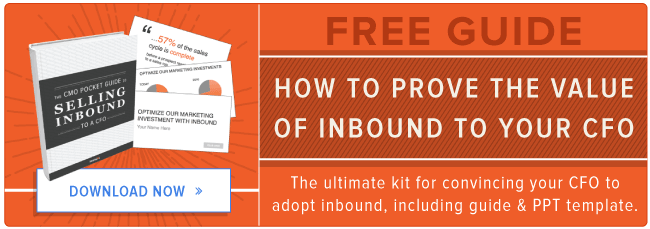
As savvy marketers, it’s easy for us to get excited about implementing an inbound marketing strategy or writing our next blog post — we know that the content we’re creating will attract and generate qualified leads that will turn into customers.
And to fully implement our plan, we’ll usually need to gain buy-in from other company stakeholders. Often, this will happen in our quarterly budget meeting. We’ll be looking to shift some resources from PPC to inbound, hire additional inbound marketers, or engage a marketing agency, and have to convince someone in finance that this is a really awesome plan.
It doesn’t always go according to plan — often, there’s a disconnect when it comes to explaining our inbound plan to finance folks. They might say, “Sure, you can do inbound. Just don’t touch the budget we have earmarked for paid campaigns — we know these programs lead directly to leads/opportunities/customers.” Or, they ask the inevitable question, “So tell me, how much new revenue will that ebook or blog post bring us?”
The good news is that once you have inbound marketing and the right software in place, you can close the loop and prove your success to your finance with hard numbers. But for those marketing leaders trying to get their CFOs on board with the whole inbound vision before they have those components in place, here are some tips on how to get your finance folks as excited about inbound marketing as you are.
Talk About Assets
To those in finance, an asset is the next best thing to revenue. Assets have value. They’re considered goods or property. They offer benefits and advantages to help meet debts or legacies.
Some assets depreciate in value over time — like your car. But some assets can grow in value the longer you have them, like gold, precious gems, stocks, bonds, and real estate. Finance people adore assets that grow in value, especially when assets don’t require any additional investments.
Inbound marketing creates assets. Every blog post, ebook, infographic, white paper, video, presentation, landing page, CTA, email, lead nurturing series, workflow, process you document, system you put in place, is an asset. And the best news is that those assets grow in value without needing to make any additional investments.
Compare Marketing to Compound Interest
One of the best things about content is that it attracts visitors, leads, and customers long after you publish it. You can see this in your analytics — once a blog post is published, for example, it attracts a lot of traffic initially and then gradually tapers off.
Years later, that blog post is still driving traffic and generating leads, even if there aren’t a lot. It’s akin to making deposits in a savings account that earns compound interest. Even if you never published another blog post, you can keep earning compound interest in the form of leads that are generated. Start speaking about inbound marketing as “assets that generate compound interest” with your finance folks, and they may just start to drool.
For even more emphasis, highlight real-life examples. Use your own blog as an example, cite this example of a compounding return from Tomasz Tunguz’s blog, or use this example from HubSpot. In the HubSpot example, you can see that over 90% of HubSpot’s blog leads come from old posts (i.e. posts published prior to that month). Furthermore, over 56% of the leads we generate come from marketing we are no longer actively doing.
Explain the Difference Between Renting vs. Owning
You’ll notice that finance will often use the word “attribution” a lot. For that team, being able to connect the dots between cause and effect is crucial. It’s concrete, it’s provable.
You’ll also notice that finance people tend to be favorably inclined to PPC. Why is that? It’s because they can directly attribute how many leads are generated from PPC to how many of those leads become customers (and how much revenue those customers brought in).
To a finance person, spending $X thousands to get X hundreds of leads that generates $X thousands in revenue is direct attribution. They get that. To help finance people get off the PPC bandwagon, describe PPC as “renting” space on someone else’s site. As long as you keep paying rent, you have that space and people will find you. But as soon as you stop paying rent, no one will find you. PPC is pure expense. Worst of all, the rent can go up within seconds, without warning, forcing you to either give up your coveted space for a less desirable one (lower placement) or having to accept fewer leads.
CFOs hate unpredictability. And PPC can be extremely volatile depending upon how competitive the keyword landscape is for your market.
In contrast, inbound marketing is about “owning” real estate. (Real estate is an asset.) Every time you add another asset (blog posts, content offers, etc.), you increase your real estate’s value. Collectively those assets will keep generating a compound interest effect, without you even adding more assets. In reality, you’re doing more than just occupying real estate. Inbound marketing is about building a lead generation factory — complete with content, systems, processes, workflows, etc. — which adds to the company’s overall value. And anything that adds value to a company also increases shareholders’ value.
Increasing shareholder value is the raison d’être of your CFO. Think she might perk up and be more supportive of inbound marketing if she heard it explained like this? You betcha!
The Key to Converting Naysayers Into Cheerleaders
Finance folks can become your biggest cheerleaders for inbound marketing if you use language that expresses inbound marketing’s value in financial terms. Be consistent. Be open. Show them the hard numbers. Show them how the dots connect. Eventually they will become inbound marketing’s biggest fans.
![]()







